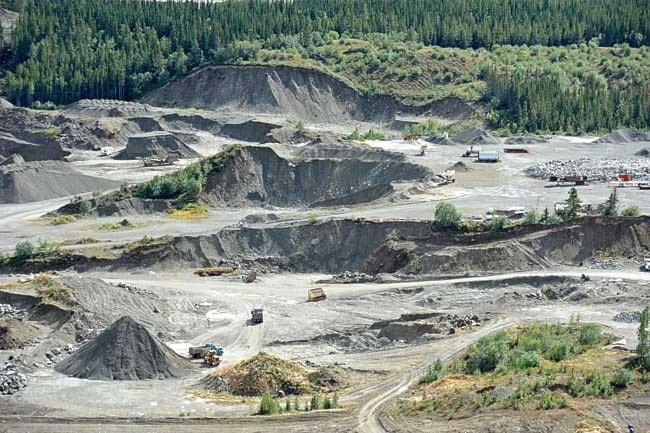Today is the last day the Yukon Environmental and Socio-economic Assessment Board will accept public comments about a controversial gravel pit near Teslin.
The deposit, 13 kilometres north of the community, is a small one.
Its estimated 10,000 cubic metres of gravel gives the pit a lifespan of around four years.
But it comes with sizable problems.
And there are concerns about a nearby residence, a school bus zone, access roads and noise pollution, said Jennifer Clark, the manager of the assessment board’s designated office in Teslin.
The development would severely limit access to two nearby settlement land parcels, according to a submission to the board from Danu Environmental Services, on behalf of the Teslin Tlingit Council.
It is also concerned about the impact on Ten Mile Creek, which is located right beside the proposed pit.
Water quality and chinook salmon stocks may suffer if the pit is built, it wrote in a letter to the Yukon Environmental and Socio-economic Assessment Board.
The First Nation has imposed voluntary restrictions on fishing over the past few years and many residents use the creek as a main drinking-water source because of poor groundwater quality, Danu Environmental Services said in its written submission.
As well, the site sits on an aboriginal trapline.
“It has been there for us to access for over 100 years,” Tod Smarch wrote to the assessment board on behalf of his family, which includes the Smarchs, Keenans and Dewhursts.
“Not very many people can say that literally they follow in their grandparents’ footsteps like we can. To keep our traditions strong, the least amount of interruptions to the land would be a benefit to our Tlingit culture and to the wildlife.”
The families’ concession sits at the start of the 10 Mile Creek Valley - the last undisturbed wildlife corridor leading to their trapline, wrote Smarch.
Experience with development from things like sewage lagoons to community trails across the Fox Creek Valley has caused significant drops in game for their trapline over the past five to 10 years, he said.
“Our concession has been recognized by North American Fur Auctions to be a top lot this spring,” he wrote. “To disturb the valley would jeopardize the harvest of our fur for the season ... upcoming seasons and possibly the years to come.”
The proposed pit is the Yukon government’s baby.
It needs the gravel deposit to support local projects in Teslin and along the Alaska Highway, it said.
That’s just laziness, said Smarch.
“We feel that it is an easy way out for the Yukon government Highways Department to set up a pit to save money at the expense of nature, land and wildlife,” he said.
They could continue using the Deadman Creek pit a few kilometres down the road, find different and better fuel options for their trucks or take some more time with the First Nation to find a better location, he suggested.
And it’s not like the government needs gravel.
The territory is not facing a shortage, said officials.
“Gravel supplies are not a concern,” said Ron Billingham, at the lands management branch.
But because there are so many players involved in gravel development, including Whitehorse and multiple other territorial departments and branches, no one has a real “decent” estimate on exactly how much gravel the territory needs. Or, more importantly, how much gravel is available, he said.
But there is no concern that there is not enough, he said.
Especially considering the city is on the cusp of developing the Stevens Quarry on the north end of Whitehorse.
Stevens has been a long-awaited gravel bonanza, with 1991 studies estimating 3.5 million cubic metres.
But those studies were based on a contour map, said Kinden Kosick, a city planner.
The city doesn’t know how much gravel is actually there.
“They don’t feel comfortable anymore giving estimates based on contours,” said Kosick of the company currently doing test digs at the site.
Instead, the territory will fork out another $75,000 for a sonic drill that can assess reserves buried 30 metres deep.
Only then will the company share any numbers.
“It’s just for peace of mind,” Kosick said of the further drilling. “We are expecting to be in the ball park of the 1991 estimates.”
But even if that reserve proves up, the territory will still need another 1.18 million cubic metres of gravel to meet obligations in the Kwanlin Dun First Nation’s final agreement.
The urban aboriginal group’s final agreement lists the specific amount as a condition under economic development. Both the two parcels the First Nations has started to develop at McLean Lake, and future parcels at the Stevens Quarry are listed as options to fulfill that obligation.
Chief Rick O’Brien isn’t worried the quota will be filled.
“Whether it’s there, or over here, we have the rights to so much gravel,” he said.
The two parcels Kwanlin Dun are currently starting to develop at McLean Lake are expected to hold approximately 750,000 to 1.25 million cubic metres, leaving another 70,000 to fill, at best.
The sonic drilling at the Stevens Quarry is scheduled to begin in late October.
Contact Roxanne Stasyszyn at
roxannes@yukon-news.com
